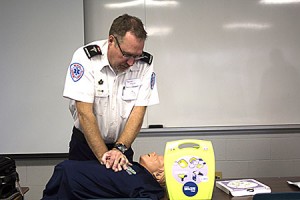BY CARMEN PONCIANO
Thanks to the Heart and Stroke Foundation and the federal government, 2,000 automated external defibrillators (AED) are being installed across Canada. The $10-million, four-year plan started in 2011 with the goal of getting AEDs in arenas, recreation centres and public buildings. Conestoga College’s Doon campus will soon receive its fifth AED. The Heart and Stroke Foundation held a training session for faculty and staff on Nov. 5.
“We are a large public building and are very happy to have received these units from the Region of Waterloo EMS (emergency medical services) through the Heart and Stroke Foundation,” said Nancy Maher, Conestoga College operational safety supervisor. “They require very little maintenance and it’s great to know that we have the equipment and training necessary to save a life.”
This device has the potential of saving thousands of people who experience a sudden cardiac arrest. Forty thousand Canadians experience cardiac arrest every year. That’s about one every 12 minutes, and without fast treatment, only five per cent survive. By combining CPR and an AED, an individual’s chances of survival can go up to 80 per cent since the AED can tell if the heart has stopped beating and restore it to its normal rhythm.
The AED models that have been given to Conestoga College are one of the few AEDs that coach you through the process by providing visual and audible instructions, meaning anyone can use them in case of an emergency.
“What I like about this particular unit is that it is very easy to use, very safe,” said Ashley Kelly, an emergency medical response worker and also an advance emergency care instructor.
After calling 911 and opening the AED case, the unit will provide a step-by-step sequence. The AED’s internal surface also has visual steps surrounding the monitor screen which take you through the entire CPR and AED process.
The first step, after clothing is removed, is to place the shock pads on the person’s chest. Conveniently, the pads have pictures of where specifically to place them. The AED will then analyze the patient’s heart rhythm and, if it can’t detect a beat, it will advise CPR be started instead. The AED will only administer a shock if it detects an abnormal heart beat.
For CPR it will emit a beat that represents every time you should press down on the person’s chest. It will also tell you whether you need to press harder.
As the pace increases, you will count to 30 until the AED says to stop and back off, since it is analyzing the heart’s rhythm once again.
If a beat is present but irregular, it will instruct you to press the button that will release a shock and notify you to start CPR again.
“After every shock, it resets the heart but we don’t know if it’s actually come back into a normal rhythm. What you are going to do is help it climb that hill, so start doing compressions. Help get it to the top so that it can start on its own,” Kelly said.
Because of AEDs’ high success rate the Heart and Stroke Foundation wants to have them within 25 metres of each other so that in case of an emergency, there is always one close by. Conestoga College’s four AEDs on the Doon campus are located by the bookstore, the security offices, in the ATS building and in the recreation centre. The fifth one coming soon will be placed in the E-wing. There is also one located on the Guelph campus and two at the Cambridge campus.
In addition to having AEDs on site, they must be kept in good condition.
“Security does three patrols per day and during those patrols they ensure the green checkmark is visible, meaning the unit is functioning,” Maher said. For more information on AEDs go to www.aed4life.com.

